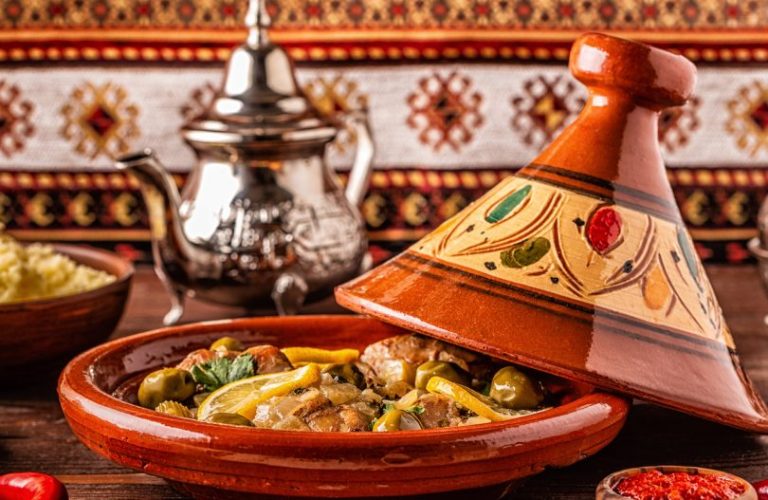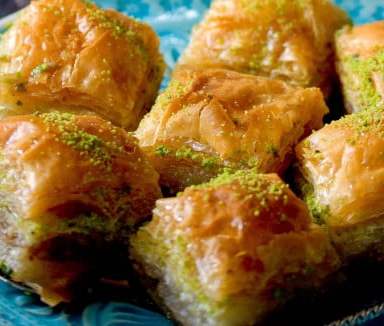Authentically Mediterranean, and rich in colors, Moroccan cuisine is the result of multiple influences: Berber, Arab. The Moroccan culinary heritage is thus very diverse, offering the same dish, as many regional variations or… Family! Moroccan cuisine also shares a number of preparations with its Maghreb neighbors, Algeria and Tunisia. The best known are Couscous, Méchoui, and of course Tagine.
The Etymology Of The Word “Tagine”
What does the word “tagine” mean? This word is a derivative of the Greek “têganon”, or “earthen dish”. The tagine is a generic name, its regional use differs according to the countries in North Africa. However, the most common use of the word “tagine” refers to the dish simmered in a clay cooking vessel with a conical lid. As well as, tagine describes a traditional clay cooking dish. Hence, “tagine” refers to the stew-like dish as well as the earthenware cooking vessel.
The word tagine, when referring to food, therefore refers to foods that have been cooked in the tagine dish. There are a very large number of different tagines, which contain meat, vegetables, and fruits (there are many sweet and savory recipes in Moroccan cuisine: tagine with olives, quinces, date figs, or apricots), all this with beef from lamb or chicken: there is really something for everyone! There are even vegetarian tagine recipes, as in this vegetable tagine recipe with olives
How To Protect Your Tagine During The First Use?
If you have chosen a traditional terracotta tagine dish, enameled or not, you will have to take care of it and especially protect it before its very first use to prevent it from bursting, or cracking when you are going to put it on a heat source, whether on a brazier or a conventional gas stove.
Before using your tajine for Moroccan cuisine for the very first time, it is recommended to immerse the two separate parts in water. You can put them in a bathtub or in a basin filled with cold water and white vinegar. The dish and lid should be completely immersed in water so that they are protected from cracks. This immersion must last at least 24 hours. Once the time has passed, drain the water from your bathtub or basin and let your tagine dish dry for another 24 hours in the open air. There is no need to put it in the sun. Just leave the terracotta dried properly before using it.
This step will not be necessary if you have opted for an electric tagine device. It is already ready to use, all you have to do is plug it in and start grabbing your meats, fish or vegetables. You can combine your tagine dish with pretty table decorations to complete the decoration of it and impress all your guests at dinner time: add on your dining table an aluminum candlestick for candles. All you have to do is make your friends and family discover all the flavors of Moroccan tagines!
What Is Tajine
Tajine is a traditional Berber dish known in the Maghreb. It is also the basis of many meals in Tunisia, and Algeria. All the more reason to decline the stew with the scents of the Maghreb although being recognized as a Moroccan dish, the Tajine remains symbolic in the sense that it represents conviviality. It is originally a Berber dish: a kind of stew, in which vegetables and meat are stewed. It is often cooked on special occasions to bring a whole family together around a traditional dish.
Where Does The Tajine Come From?
The Tajine is an invention of Berber origin. These nomadic people set up an easy-to-cook dish on a campfire. The word Tajine is a derivative of the Greek word “têganon”, or “earthen dish”. The dish would come from a hollow plate in terracotta, surmounted by a pointed lid of the same material. It is also the shape of this lid that allows the steam to circulate during cooking, making the meat of the tagine so tender. The food, simmered over low heat, cooks smothered and steamed in a hollow plate covered with a conical lid.
The Tagine: A Berber Tradition
According to some sources, the Berbers invented the tagine long before our era. The Berbers, a nomadic people, have found a simple recipe to prepare and cook with a simple “campfire”. Today, the tagine is a traditional dish of North Africa. It is found in Morocco, Tunisia and Algeria. As with traditional couscous, everyone has their own way of making a tagine. It is the spices simmered with the food that give all the flavor to this delicious dish.
According to tradition, the tagine is slowly cooked over charcoal for months without covering it. Foods are essentially composed of water, once boiling, the water turns into water vapour. It is also the circular shape of the lid that circulates the steam during cooking. Indeed, the success of the tagine is based on stewing.
Algerian And Moroccan Tagines
Algerian and Moroccan tagines are slow-cooked salty stews, usually made from meat, poultry or sliced fish with vegetables or fruits. Spices, nuts, and dried fruits are also used. Common spices include ginger, cumin, turmeric, cinnamon, and saffron. Paprika chili pepper is used in vegetable tagines. The sweet and sour combination is common in tagine dishes like lamb with prunes and spices. Tagines are usually served with bread. Since the dome-shaped or cone-shaped lid of the tagine pot traps steam and returns the condensed liquid back into the pot, a minimal amount of water is required to cook meats and vegetables. This cooking method is important in areas where the water supply is limited or where public water is not yet available.
Tunisian Tagine
What Tunisians call a “tagine” is very different from the dish. The Tunisian tagine looks more like an Italian frittata or an egg. First, a simple stew is prepared, of meat cut into very small pieces, cooked with onions and spices, such as a mixture of dried rosebuds and ground cinnamon known as baharat or a robust combination of ground coriander and cumin seeds; this is called tabil. Then something starchy is added to thicken the juices. Common thickeners include cannellini beans, chickpeas, breadcrumbs or potatoes in cubes. When the meat is tender, it is associated with the ingredients that have been chosen to be the dominant aroma. Examples include fresh parsley, dried mint, saffron, sun-dried tomatoes, cooked vegetables, and simmered veal brain. Then the stew is enriched with cheese and eggs. Finally, this egg and stew is cooked in a deep pie dish, either on the stove or in the oven until the top and bottom are crispy and the eggs are just taken. When the tagine is ready, it is turned over on a plate and cut into squares, accompanied by lemon wedges. Tunisian tagines can also be prepared with seafood or as an entirely vegetarian dish.
In rural Tunisia, home cooks place a shallow terracotta dish on olive charcoal, fill it, cover it with a flat terracotta pan, and then stack burning coals on top. The resulting tagine is crispy at the top and bottom, fluffy inside and infused with a subtle smoky scent.
What To Cook In A Tagine?
The tagine is a symbol of generosity, so it must be rich in flavors and aromas. So we usually put meat, vegetables, and as many spices as possible: turmeric, curry, cloves, cinnamon, etc. Today, there are many tagine recipes: tagines with chicken, lamb, or fruit, there is something for everyone.
The Different Recipes Of Tajine?
There are a very large number of different tagines, which contain meat, vegetables and fruits (there are many sweet and savory recipes in Moroccan cuisine: tagine with olives, quinces, date figs or apricots), all this with beef from lamb or chicken: there is really something for everyone! There are even vegetarian tagine recipes, such as a vegetable tagine with olives. The beef tagine is surrounded by chickpeas. With these different recipes, awaken your taste buds and make a trip to Morocco thanks to the thousand and one flavors of Tajine.
The following is a list of the best types of Moroccan tagine
- Moroccan Tagine With Meat And Vegetables
- Moroccan Tagine With Meat And Prunes
Prune meat tagine is one of the classic Moroccan dishes, usually cooked on special occasions such as wedding parties, and served to guests and when visiting family and friends. It is prepared with meat and cooked dried prunes. This floor is the best evidence of Moroccan cuisine .distinguished by its delicious flavors
- Moroccan Tagine With Meat And Potatoes
- Moroccan Tagine With Chicken, Olives And Potatoes
- Moroccan Tagine With Chicken And Olives
- Mroozia
Marouzia is a type of Moroccan tagine. It is often prepared during Eid al-Adha. Its main ingredients are lamb, raisins, almonds, olive oil, dry onions, and various spices.
- Sardine Kofta Tagine
Sardine kofta tagine is a Moroccan recipe that is prepared mostly during summer days. It is easy to prepare and has a distinctive and delicious taste of sardine kofta balls with tomato sauce. Sardines are the basic and cheap fish in Morocco .and accessible to all classes of Moroccan society
- Fish Tagine With Vegetables
Wonderful Moroccan food for fish, easy The preparation is delicious and has many health benefits. The fish and vegetables are marinated using Moroccan spices, then the tagine is placed .on a low heat until it simmers slowly.
How To Make Marocain Chicken Tagine
The ingredients are
- Medium-sized chicken, cut into 10 pieces, and cleaned well.
- 3 Onions chopped.
- Garlic mashed.
- 4 Potatoes cut into cubes.
- 3 Peeled carrots, cut into fingers.
- 3 Tomatoes cut into circular slices.
- Saffron melted in warm water.
- Black.
- Vegetable oil.
- Salt to taste.
The preparation
- Bring a suitable sized tagine, put it on fire, and put a quantity of vegetable oil, and the tagine is a medium-depth thermal pottery pot.
- When the oil is heated add the grated onions, continue stirring, until they wither, then add the mashed garlic, and continue stirring from time to time, until the garlic and onions take a light golden color.
- Add the chicken pieces to the tagine after removing the skin from them with good stirring, until the color of the chicken changes, then add the melted saffron in a small amount of water and stir constantly, until it takes the color from all sides.
- Spices are added to the tagine, such as salt and black pepper, and continue to stir the tagine.
- Add the potatoes, chopped carrots, and constant stirring, then pour a glass of water over the tagine with stirring, leaving the tagine, until the vegetables are cooked on a low fire.
- Then add the tomato slices, a small amount of black pepper, and salt, and leave the tagine on the quiet fire, until the tomatoes wither.
- The tagine is placed in the oven to brown the face, get the golden color, and the attractive.
- After the face of the tagine is browned, decorate it with a few slices of green olives and chopped parsley.
- Serve hot chicken tagine next to a white rice dish, which can be prepared quickly and easily.
- Decorate the rice dish with chopped parsley and bon appetit.
The dish that reached the moon!
In addition to being delicious and important, the Moroccan tagine proved to the world that the heritage of kitchens can help global modernity develop when NASA included the Moroccan tagine dish on the list of dishes that can be relied upon to feed the pioneers of its vehicles bound for mars, and even presented it in training experiments, because of its health advantages on the one hand, and because it is able to withstand the conditions of space life and temperatures on the other.



